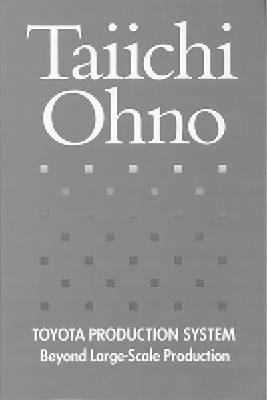Toyota Production System
TAIICHI OHNO
Reviewed by Todd

The Japanese automotive industry was in its infancy following World War II. The total market in Japan for passenger cars in 1949 was 1,008 units. Many of the industry’s executives looked with envy across the Pacific. The five-million-unit U.S. market and the mass production techniques born from Henry Ford’s assembly line granted their American counterparts advantageous economies of scale.
Taiichi Ohno took exception. As a machine shop supervisor at Toyota, he saw the American auto companies reducing the varieties of styles they offered and standardizing parts to gain these advantages. He saw a very different problem in his country. “Our problem was how to cut costs while producing small numbers of many types of cars,” Ohno writes in Toyota Production System.
Toyota’s rise to global automotive juggernaut came on the back of Ohno’s system for shop floor coordination and was based on a deceptively simple insight: the absolute elimination of waste. Moving parts, waiting for parts, and even stocking parts as inventory are all forms of waste. Dealing with waste in a compartmentalized manner generates some marginal gains, but nothing compared to the quantum improvements possible when waste is dealt with on a system level.
Ohno’s Toyota Production System is supported by two pillars: just-in-time and autonomation. Just-in-time is often referred to as pull production. Rather than use a centralized production schedule, each operation requests parts from upstream feeders based on their current needs, meaning engines are assembled when final production signals the need. Autonomation is the concept of giving machinery human intelligence—for example, enabling a lathe to detect faulty material or a broken tool. Smarter machinery reduces the risk of defective parts and creates a shift from craftsmen running individual machines to a team of semiskilled generalists able to handle several pieces of equipment.
The advances Ohno made were direct results of his natural curiosity and observation of the world around him. The decentralized decision making of his pull system mimicked the human body’s unconscious variation of the heart and lungs based on its level of exertion. The concept of teamwork didn’t really exist in Japanese culture until the import of Western sports like baseball and volleyball after World War II; traditional Japanese sports, like sumo wrestling and judo, focused on the individual. And Ohno’s early years working in Toyota’s textile department exposed him to operations where one worker could keep forty or fifty self-repairing looms running, leaving him shocked when he moved to the automotive individual craftsman mentality.
In the mid 1990s, I instituted a pull system for bringing raw materials into a GE plant in Columbus, Ohio, and I learned the benefits of this system firsthand. Prior to the change, purchasing and production control developed monthly schedules and ran extensive computations to determine material requirements. Purchase orders were placed and suppliers made shipments based on the initial plan. But nothing ever operated according to plan. Shifting customer demands, variable product yields, and inconsistent machine uptime all led to too much or too little of what was needed. By setting up standard ordering quantities and simple barcode tags, operators on the floor took charge of ordering the raw materials they needed. Materials were moved from a centralized warehouse to the factory floor. When completed, the project lowered the cost of purchased inventory by $2 million, or over 30 percent, but most important, the change to pull eliminated material shortages caused by the drawbacks of centralized planning.
“Industrial society must develop the courage, or rather the common sense, to procure only what is needed when it is needed and in the amount needed.”
Several books have been written about Toyota and its production system, and Ohno’s is the best. At 120 pages, it is a quick read, but his three decades of refining the system brings purity to the elements of his argument for a new systemic view of organizing supply chains. But there is one other advantage as well. What sounds like a completely internal effort is really about producing exactly what your customer wants when they want it. Ohno says the closer Toyota has gotten to the 100 percent elimination of waste, the “clearer [becomes] the picture of individual human beings with distinct personalities.” While this conclusion is not an obvious one, it ultimately shows the elegance of the efficient system he created. TS
Toyota Production System: Beyond Large-Scale Production, Productivity Press, Hardcover 1988, ISBN 9780915299140
WHERE TO NEXT?
 Here for
more on self-sustaining systems
Here for
more on self-sustaining systems
 Here for
what Ohno was improving on |
EVEN MORE: The
Machine that Changed the World by
James P.Womack, Daniel T. Jones and Daniel Roos;
The Toyota Way by Jeffrey K. Liker; The
Elegant Solution by Matthew E.
May
Here for
what Ohno was improving on |
EVEN MORE: The
Machine that Changed the World by
James P.Womack, Daniel T. Jones and Daniel Roos;
The Toyota Way by Jeffrey K. Liker; The
Elegant Solution by Matthew E.
May